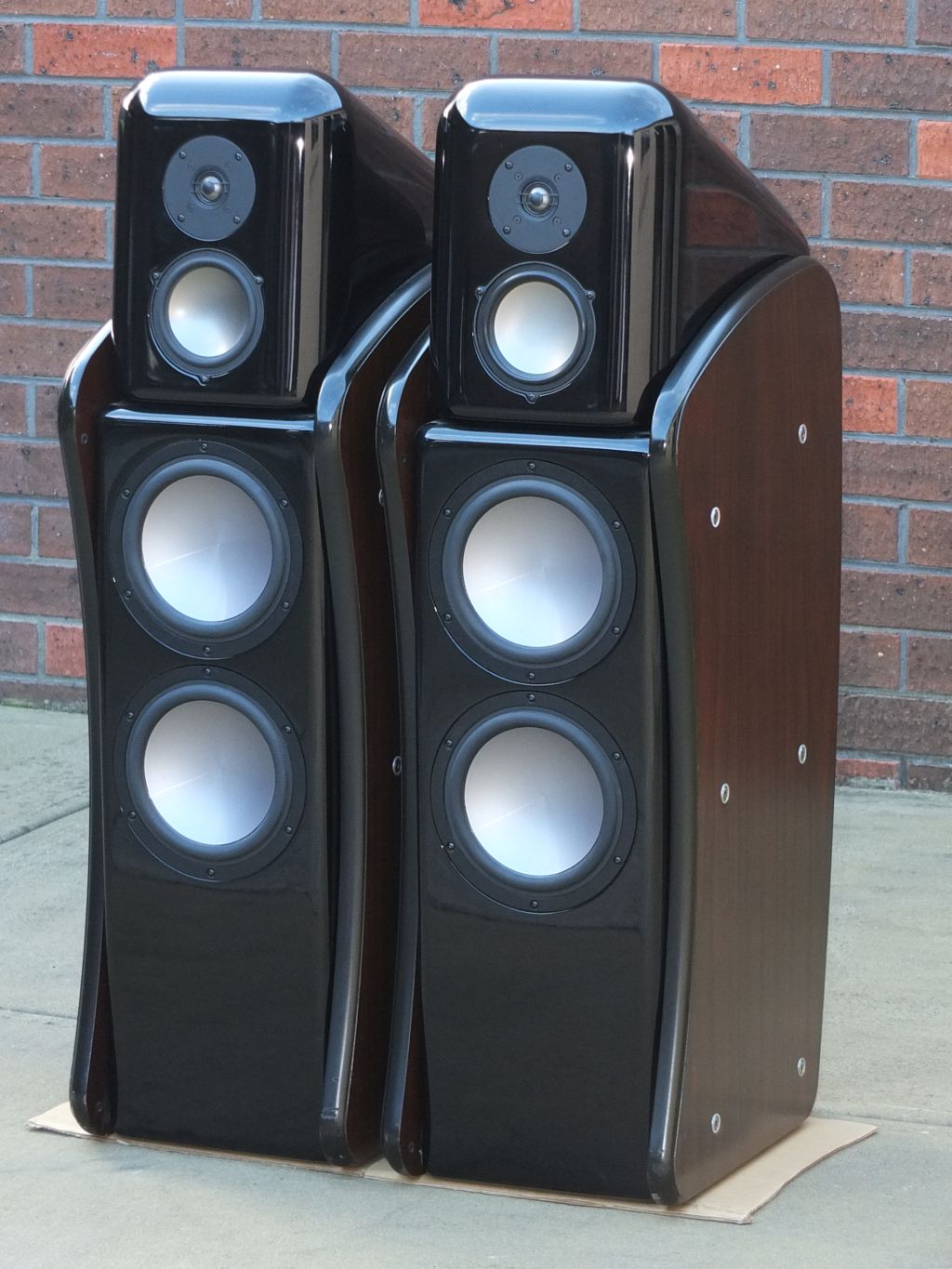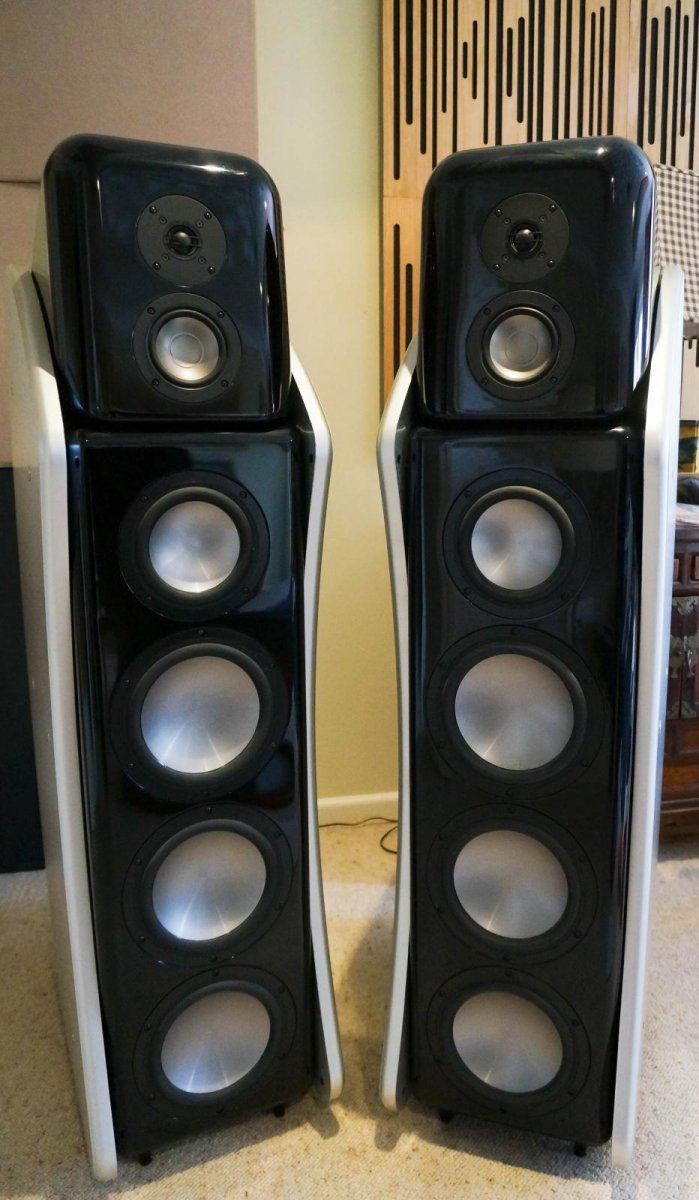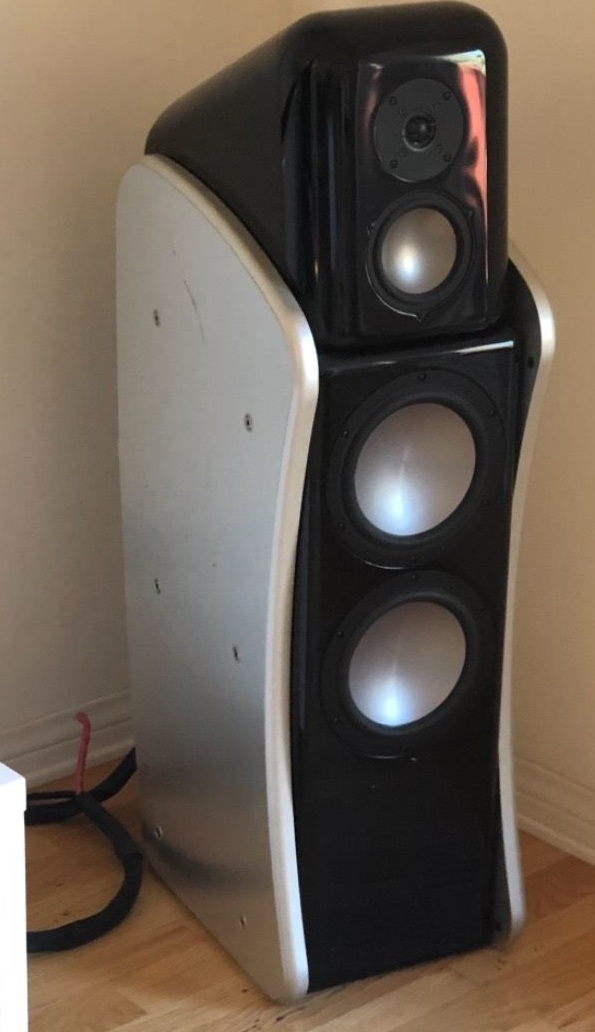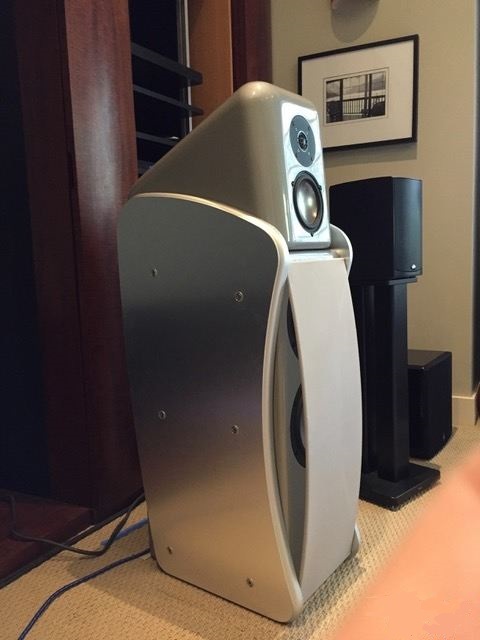Revel Ultima Studio 1 (Piano Black)
Manufacturer’s specs
Drive-units: 1″ aluminum-alloy front tweeter with roll surround, 0.75″ cloth-dome rear tweeter, 5¼” inverted titanium-dome midrange, two 8″ mica/carbon-filled copolymer inverted-dome woofers. Crossover frequencies: 220Hz, 2.2kHz via 24dB/octave networks. Frequency responses: in-room response and first-reflection, 31Hz-12kHz, ±1dB; listening window, 31Hz-20kHz, ±1.5dB. Low-frequency extension: -10dB at 22Hz, -6dB at 26Hz, -3dB at 33Hz. Impedance: 6 ohms nominal, 3 ohms minimum. Sensitivity: 87dB SPL with 2.83V at 1m (4-pi anechoic).
Dimensions: 1114 mm H by 323 mm W by 429 mm D. Shipping weight: 74.3 kg each.
From bottom to top, the Studio’s performance exuded authority and integrity. Whether the fare was background sounds from FM, jazz, pop, rock (well, a little), or my regular diet of symphonies and operas, I enjoyed a closer connection to the music when the Studios were in the system—even though the speakers were not forward-sounding, and tended to create a deep soundstage extending far behind them. While they didn’t “disappear” as completely as the Artemis Eoses or the EQ’d Kharma Ceramiques, the Studios pulled off that trick most of the time. In addition, they provided a more solid center-fill, and as palpably as that of the Meridian TriField setup, which uses a center-channel speaker.
The better the recording, the better the Studio sounded. On The Long Black Veil (RCA 62702-2), each of the Chieftains’ guests, from Sinead O’Connor to Tom Jones, was absolutely and solidly placed and characteristically distinct, effectively approaching the devastating immediacy of the Cowboy Junkies’ famous The Trinity Session (RCA 8568-2-R). And when I played that disc…Wow! Margo Timmins’ voice was so eerily real that I felt I should have been able to feel the warmth of her presence. The Studios added to this a re-creation of Trinity‘s vaunted ambience even beyond that offered by Meridian’s five-channel decoded Ambisonics. The in-room illusion was well-nigh perfect.
With the Studios providing such a wonderfully open window onto recordings, I was compelled to dig back into my collection and rediscover some favorites. One old friend is Kodály’s Dances from Marosszek, with the Budapest Philharmonic under Arpad Joo. Even though the LP (Sefel SEFD-5014) is derived from a SoundStream digital master, I prefer it to the CD because it better separates the instruments and the ambience from the residual noises of the media and processing. On the other hand, the CD (Arts 47379-2), remastered by Bruce Leek, does a better job of distinguishing instruments and their immediate auras from the hall’s surrounding reverberation. Issues of frequency balance, distortion, and dynamics were beyond contention. How remarkable to have, with the Studios, the ability to limn such subtleties—and yet be able to ignore them by reveling in the sheer beauty of the sound!
But I hadn’t fully experienced the joyous sound the Studio could make with non-audiophile discs until I played Seiji Ozawa’s recent recording of Poulenc’s Les Mamelles de Tirésias (Philips 456 504-2). Poulenc’s opera-bouffe wraps Apollinaire’s superficially silly dialogue in some of the ripest, sauciest, most lyrical music of the last century. The scoring is richly romantic, melodic, and often wildly eccentric. In fact, I gave up on the libretto and simply let the Studios tear into the magnificent sounds and melodies. Song after song, scene after scene, I had absolutely no idea what was going on between and behind the Studios, but damn—it was fun and it sounded great.
Conclusions
Since joining Stereophile, I have had the pleasure and responsibility of reviewing some of the best music equipment on the planet. Still, I ship most of these fine components back to their manufacturers with little regret—I know something new is on its way, and I need the closet space. I’ve had the Revel Ultima Studios in my system for longer than I’ve had any other piece of review equipment, and I’ve made more accommodations for them than I have for any others. To mangle Jack Nicholson’s compliment in As Good As It Gets, the Studios make me want to have a better room.
The Ultima Studios have given me unabated pleasure as well as utility—their accuracy and transparency across the audible range make them powerful tools for assessing other components and sources. Inferior sources are revealed for what they are, and one must be prepared to hear just that. But this also means that the Studios let the music’s humanity and joy shine through into my listening room. Highly recommended.
Studio and Sophia
If you are shopping for speakers in the Revel Studio’s price range — or have even more money to spend — you should seek out the Wilson Audio Sophia, a speaker I reviewed very favorably late last year. Given their similar prices as well as the companies from which they come, the Sophia and Studio are natural competitors, and I would be surprised if there are any stores in which you can hear both. So what will you hear when you make the effort to audition these two five-figure titans?
The differences I hear, and they are considerable, come down to a matter of vocabulary — the words that come quickly to mind when describing each speaker. With the Studios, I keep coming back to the audiophile lexicon — neutrality, detail, air, and ambience retrieval. There are few reviewing terms that the Studios don’t address in a positive way. Likewise, the Sophias offer loads of detail and neutrality, but they also sound more relaxed and tangible — more human. In their combination of traits, they seem to point toward a higher calling, one that puts them at one with the artistry, emotion and beauty of the musical message. To what specifically can this be attributed? I could speculate, but in the end it’s a matter of all the elements of the speaker working together to present the music in this way — it’s not an accident. The sound of these two speakers most likely boils down to different sets of goals, and I can say that both the Revel Ultima Studio and Wilson Audio Sophia present music in ways that serious listeners will enjoy — though probably not the same listeners to the same degree.
One specific region I focused on with these two speakers was the bass, as my perceptions changed, and then changed again, over time. I A/B-ed a number of recordings and finally came to the conclusion that while both speakers go similarly deep, the Sophia’s bass is more weighty. The Sophia’s greater weight made discerning the similarity in depth a real challenge. Both speakers reach into the 30s, so neither needs a subwoofer. Wilson Audio and Revel make them, however, and with the Sophia and WATCH Dog at least, a combination I’ve heard, the results are very impressive.
Conclusion
The Revel Ultima Studio is the kind of audio product that reminds us how much thought and execution go into making equipment aimed at re-creating live music. Its pedigree, as a member of the Madrigal family, is high, and its sound befits the effort that went into its creation and manufacture. Its highs soar and its bass plumbs, it can unravel a recording like few other speakers, and its overall precision makes it a very useful reviewing tool, provided the writer doesn’t do most of his reviews on low-powered tube amps. While I am convinced that some listeners will prefer a speaker that wears its science less on its sonic sleeve, even these people should hear the Studio to know what’s available, and possible, in the slightly-over-$10,000 price range.
The Revel Ultima Studio comes close to the goal of a great preamplifier: to pass the signal along with as little editorializing as possible. How close is an issue that’s impossible to address with certainty, but the Studio still raises it, which is an achievement.




